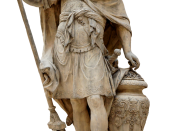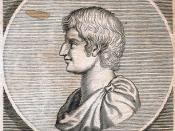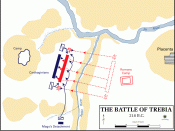Hannibal In 237 B.C., Hamilcar Barca took his nine year old son, Hannibal, to the alter of a Carthaginian god and made him swear that he would always be an enemy to the Romans. Hannibal and his father then left for Spain. The center of Carthaginian power in Spain was the city of New Carthage(modern Carthagena). Hannibal saw firsthand his father's techniques for war (Green 9).
When Hamilcar died in battle in 230 B.C., his son-in-law, Hasdrubal, became general and continued Carthage's influence in Spain. In 226 B.C. Hasdrubal signed a treaty with the Romans. The treaty stated that neither army could cross the Ebro River in northern Spain (Charles-Picard 11).
When Hasdrubal was killed in 221 B.C., the Carthaginians unanimously elected twenty-six-year-old Hannibal to be commander of the army in Spain. He continued to conquer land without crossing the Ebro River, except for the city of Saguntum, an ally of Rome.
When Saguntum began trouble between Carthage and Rome in 219 B.C., Hannibal raided the city. This began the Second Punic War. Hannibal began a long and dangerous journey, with battle elephants marching at the front of his army (Green 21).
Hannibal left a lasting reminder of his deeds in the names of Spanish places such as Potus Hannibalis, Insula Hannabalis, and Scalae Hannibalis (Lancel 12).
In the spring of 218 B.C., Hannibal handed over command of the Spanish armies to his brother Hasdrubal. He then led his troops north toward the Pyrenees Mountains and began one of the most famous journeys in history (Green 24).
Hannibal's army included Libyans and Numidians from North Africa, Iberians and Celtiberians from Spain, and Gauls from Spain, France, and Italy. There were ninety thousand foot soldiers, twelve thousand horsemen, and several dozen war elephants. Hannibal used the elephants to break...


